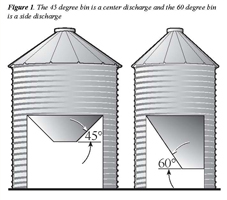Bulk feed ingredients storage
Bulk ingredients storage:
Processing feed requires storage of ingredients
in either bulk or bagged form. Micro ingredients such as vitamins
or medications are often stored in bagged form, while ingredients
such as soybean meal or dical are stored in bulk form. Ingredients
stored in bulk form are delivered to the feed processing center
in 3- to 20-ton shipments. Bulk ingredient bins should be
used exclusively for one ingredient. For example, soybean
meal should not be placed in an empty dical bin if the soybean
meal bin cannot hold all the meal when delivered.
The importance of proper ingredient storage is highlighted in the Food and Drug Administration’s (FDA) Good Manufacturing Practices (GMPs). These regulations stipulate that incoming ingredients should be accompanied with a label and that an accurate inventory of medicated ingredients, including the date of use, be kept. Bulk ingredient storage must be designed, constructed, and installed in such a manner that facilitates inspection and clean out of the bins and mill. Proper planning, design, and installation of bulk storage will help meet regulatory compliance and enhance the efficiency and profitability of the feed manufacturing operation.
A 2- to 8-week supply, of bulk ingredients should be maintained in storage. Bulk bins should be sized at a minimum of 125 percent of the expected purchase increment. For example, if 20 tons of meal are purchased at a time, the minimum bulk bin capacity should be 25 tons. Allowances should be made for bad weather, delayed deliveries, and rush seasons. Price advantages from timely, seasonal, or volume purchases of ingredients may result in additional storage space being required. With proportional mills, volume purchases may reduce the adjustment required in rations. For each new shipment of ingredients, proportional mills require adjustment since moisture, protein, energy, fiber, or other nutrient contents may vary appreciably between purchases.
Producers using a portable grinder-mixer often store soybean meal in bulk form. Depending on usage, dical and calcium also may be stored in bulk form. All other ingredients should be handled in bagged form when using a portable grinder-mixer. A stationary mill setup may store the other ingredients in either a bagged or bulk form depending on their usage rates.
Table 1, intended only as an aid in planning ingredient storage requirements, presents approximate ration compositions. Table 2 gives approximate ingredient needs for various production units and periods. The values in Table 2 may be multiplied by the appropriate number of production units to estimate the storage space required. Other factors that need to be considered include medicated early weaning, segregated early weaning, split sex feeding and phase feeding.
Types of Storage
Feed ingredients are stored or temporarily held in a variety
of structures. The following are normally employed:
- Ground level, flat-bottom bins with unloading augers are normally used for the storage of grain. These bins may be sized for a two-week to one month supply (in systems where all grain is purchased), or they may hold a one-year supply when the producer is feeding grain produced on-farm. Ground-level, flat-bottom bins cost about $40 to $50 per ton capacity, on a turnkey basis.
- Ground level, hopper-bottom bins are normally used for soybean meal, complete rations and/or grains, such as oats, that are required in relatively small amounts. These bins cost two to three times as much per ton capacity as flat-bottom bins.
- Overhead bins normally are used to provide gravity flow to processing or mixing equipment. Because these bins are expensive (about twice the cost per ton capacity as ground level, hopper-bottom bins), their use must be justified by flexibility, efficiency and labor savings in feed preparation. Overhead bins in high volume systems are sometimes used to temporarily hold complete rations. Overhead bins are called working bins and are not intended for long-term storage.
- Bagged ingredients are normally stored on pallets or a raised wooden platform. Small pallets can be moved by a portable hand-truck.
More than one type of bin may be used for a single ingredient.
As an example, large truckloads of soybean meal may be received
in a ground level, hopper-bottom bin. The meal can then be
transferred to an overhead, working bin as needed for processing.
Hopper-bottoms are probably most justified on those bins emptied
and refilled many times and those for which complete clean
out is important. Complete clean out is important in bins
holding purchased grain or those used for different ingredients
at different times. Two bins, or a two compartment bin, for
a single ingredient will permit complete clean out of one
unit while using from the second, assuring no long carry-over
of material in the bottom of a bin.
Hopper-bottoms must be steep enough to cause free-flow of
the material (Figure 1). Grains require a hopper slope of
at least 37 degrees. Soybean meal is not a free-flowing material.
Bins for soybean meal must be designed for the weight and
flow characteristics of the material. The slope of the valley
angle (shallowest corner angle) in hoppers for soybean meal
and other materials that do not flow freely should never be
less than 50 degrees with 60 degrees preferred. Experience
indicates it is better to use large intake openings with reduced
or stepped pitch flighting in the loading section on the conveyors
used to remove the product from the bin than to use agitators.

Summary - Bulk ingredients storage
Handling ingredients in bulk can reduce purchase cost per
ingredient if sufficient quantities can be handled with the
equipment and storage. If at all possible for on-farm application,
all medicated ingredientsshould be purchased in bagged form
to minimize the potential of carry-over. This reduces residue
problems in the storage structure and handling equipment.
If medicated ingredients are purchased in bulk form, a dedicated
bulk bin should be used. All bulk bins should be clearly labelled,
or numbered, to avoid any
cross-contamination of ingredients while filling a bin or
mixing feed. Proper flushing and sequencing of feeds must
follow usage of medicated feed to be in ncompliance with Good
Manufacturing Practices.
Credit: Kim Koch, North Dakota State University










